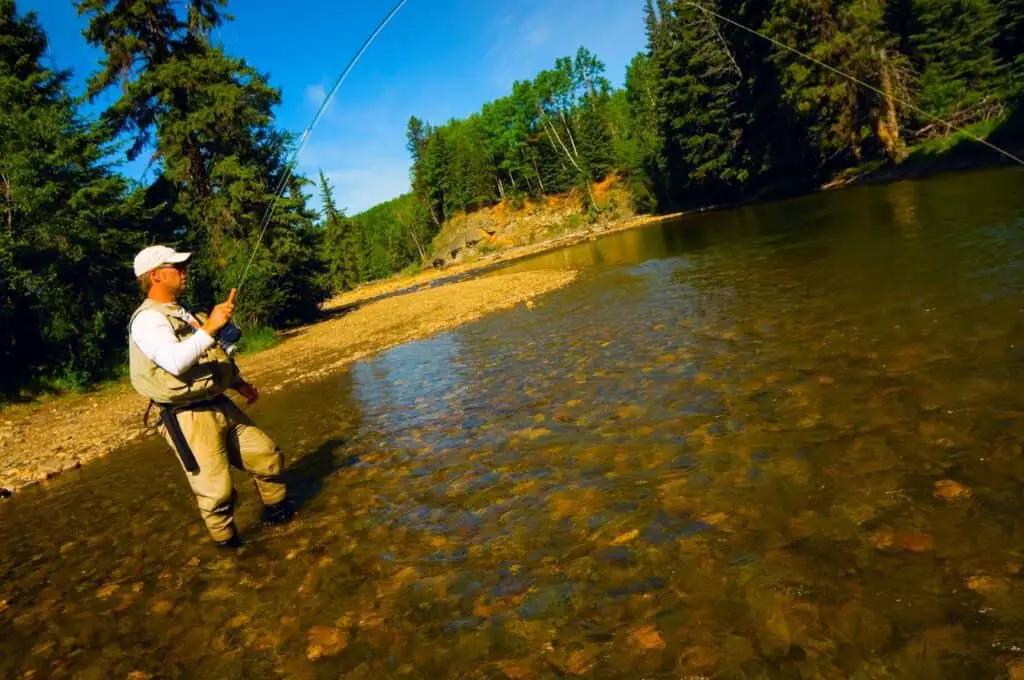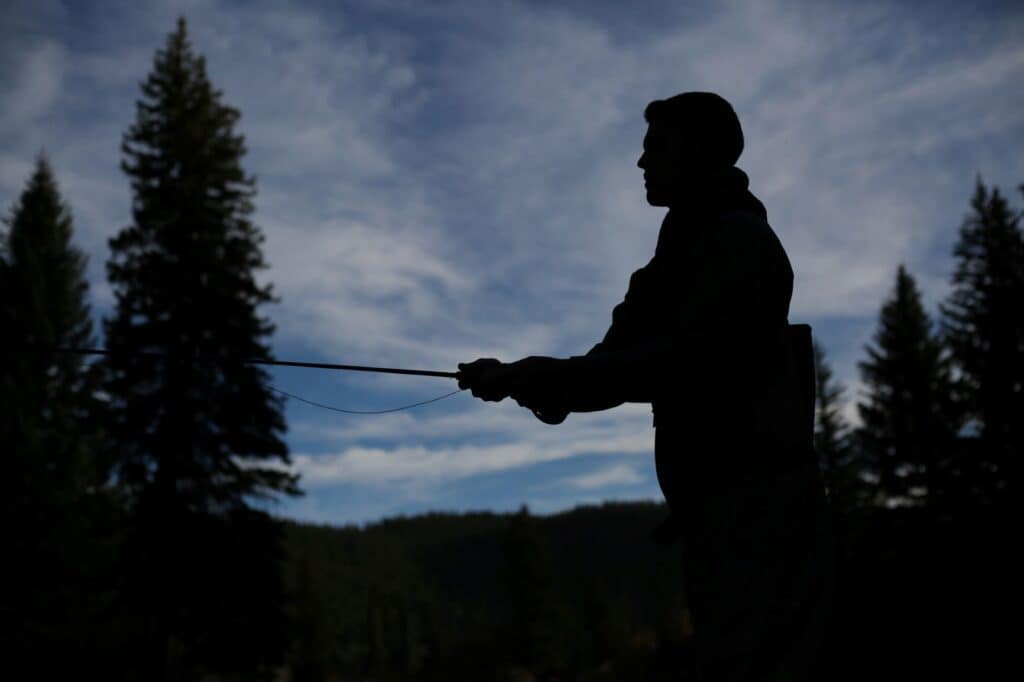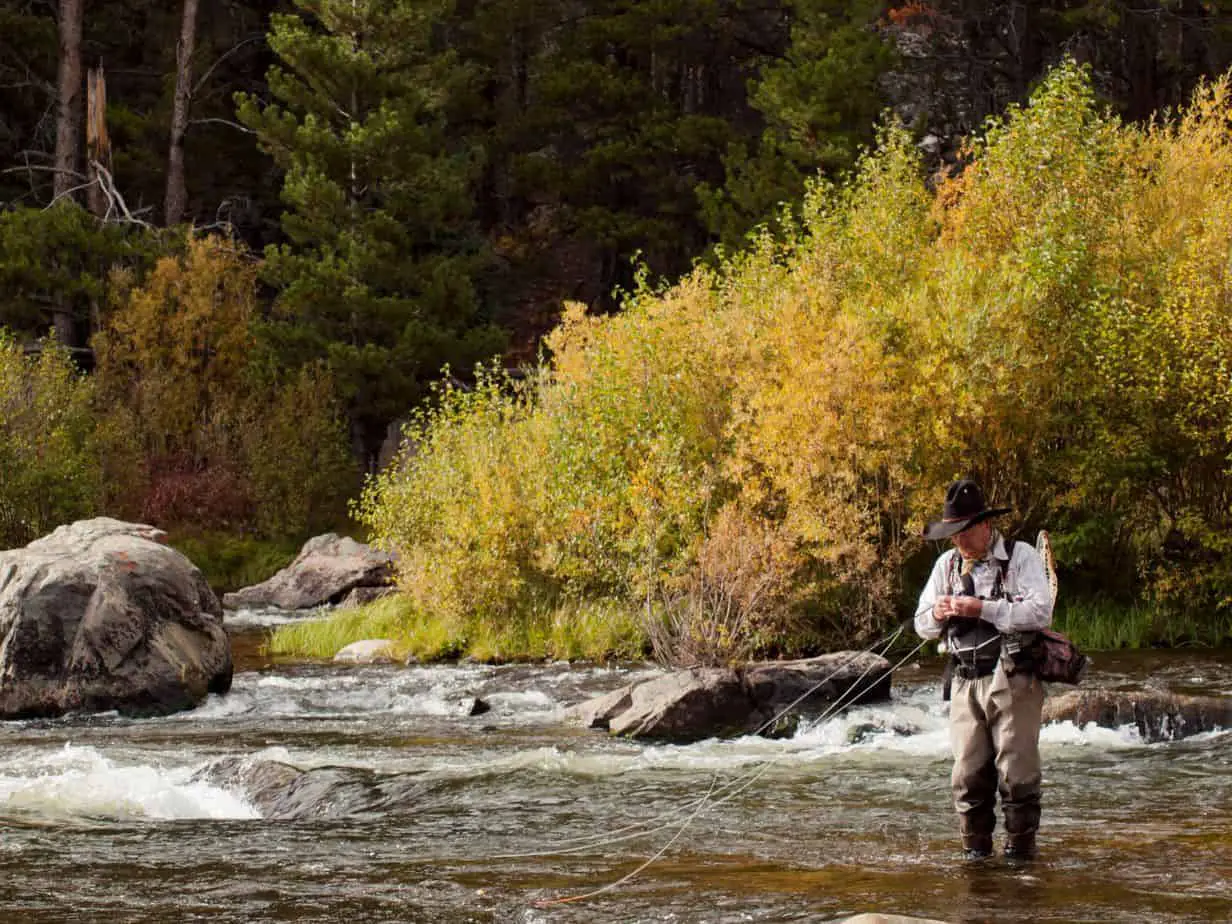Across the United States, there are so many trout rich states to select from that choosing the right one to pick for that fishing trip can be difficult. May I present Maine as a definite contender for that selection!
Maine is held in great reverence for fly anglers. The history of fly fishing goes back well over a hundred years in Maine, and many unique fly patterns and techniques can follow their heritage right back to this state.
So, if you want to catch trophy trout in abundance in a state that offers a backdrop of stunning beauty and can boast over 6,000 fishable streams, creeks, lakes, and rivers, then Maine is the place to be!
What Do I Need To Know To Trout Fish In Maine?
Before you set out to explore the trout fishing in majestic Maine, we will discuss a few factors that you should consider.
Do I need a license to fish for trout in Maine?
If you are over 16 years of age, then a fishing license is required to fish for trout in Maine. These are available at outlets throughout the state and can also be purchased directly online from the Maine Department of Inland Fisheries and Wildlife website. (IFW)
What species of trout can I fish for in Maine?
Native Brook Trout are what most anglers associate with Maine. These fish thrive in the cool waters of the state and provide fantastic sport for the angler. As well as these natives, the IFW also stock many waters. These are mainly Brown and Rainbow Trout, and they thrive in the perfect conditions that Maine offers.
Is there a trout fishing season in Maine?
As a general rule, you can fish for trout in Maine from 1st April through to the 30th September. However, there are restrictions within these dates and exceptions to the rule. All rivers are restricted to these dates. From 1st April until the 15th August are open to all methods, then from 15th August until the season closes on the 30th September, the fishing is restricted to artificial lures and flies only.
The season is the same for lake fishing, but there are no ‘type’ restrictions to the usable methods. However, in the South Zone of the state, the lakes remain open for fishing all year round. Once again, full details are available from the IFW website.
It should also be noted that certain fisheries do operate a fly or artificial lure policy the entire year-round. If you are not sure, it is better to check this beforehand.

Where Is The Best Trout Fishing In Maine?
Setting out to answer this question is made impossible by the sheer scope and breadth of trout fishing that this great trout state offers. It is simply too rich in trout fishing opportunities to do anything else than touch on some of the Maine highlights. (a bit of clever wordplay!)
So, bearing that in mind, let’s delve into some of the trout rich spots in Maine.
Kennebec River
This 170-mile-long river is entirely situated within the state. The main river is formed by the confluence of two forks, the East and West branches. These branches flow into Indian Pond, and the river emerges from there. It also has an intersection with the Dead River in Forks Township, and this is where the river really widens out. From there, it flows into Wyman Lake in Moscow before eventually making its way to the Atlantic.
Famed for its trophy-sized Brook Trout, which can reach over 5lbs in weight and 20” in length, this is one of the finest trout rivers on the whole eastern seaboard.
The upper stretch of the river is the place where these beauties are most prolific, so if you want to catch some of the finest wild Brook Trout in the country, then this is where you want to be heading. You want to be fishing upstream of Salon for wild trout, as the river is not stocked above here.
Below this, there are regular stockings of Brown and Rainbow trout, and these prosper in the river. Rainbow trout measuring 20” plus are not uncommon, and the Brown trout can also reach trophy size.
This is a large river that varies in character right along its length. Knowing where to fish it if you are without local knowledge can be difficult. We will touch briefly on some of the hotspots below, but if you want to make the most of a visit to this river, then it might be worth considering a local guide.
It is impossible to cover a river this size and mention every hotspot. If you were to start somewhere, then the region where the Dead River joins the Kennebec is a renowned spot.
There are several public access points to this area along Highway 201. As well as Brook Trout, this area also fishes well for rainbow and brown trout, and there is always the chance of hooking a landlocked salmon!
Another frequently fished area is the tailwater below Wyman Lake. This area is renowned not only for its Brook Trout but for having the only wild population of Rainbow Trout in Maine.
The Kennebago River
This is a river for the purist. The Kennebago is a fly only water and doesn’t offer much in the way of easy access. This river is stuffed full of large Brook Trout as a result of it being lightly fished. It also has a smaller population of Brown Trout and occasional landlocked salmon.
The Kennebago originates close to the Vermont border at Big Island Point. It flows through two lakes, Little Kennebago Lake and Kennebago Lake, before terminating in Cupsuptic Lake.
This river is a must-visit for fly fishers, and I don’t think a 4-weight rod will cut the mustard on this river. If you make a trek out to the river, you would want to consider at least a 5-weight rod and perhaps even a 6-weight!
The river abounds with trophy fish, Brook Trout of 5lbs and above are common, and if you hook a landlocked salmon, you will be glad you brought that heavier kit.
The upper reaches of the river are slightly different in the character of the fish. Although there is an abundant Brook Trout population, they tend to be smaller than downstream (relatively speaking).
The further downstream you head on this river, the larger the trout get, but at no point is the fishing easily accessible. The river can only be accessed either by hiking or the occasional unpaved road for its entire length.
The river fishes well throughout the season. Although spring and fall are considered the optimum times, the summer fishing can be fantastic, at least partially down to the dragonfly hatches that can be prolific during the summer months.
However, don’t arrive on this river too early in the season because it doesn’t begin to fish well until the ice on the lakes has melted, generally around the middle of May.
One great way to fish this river is to camp close by and negate those treks in and out. There are numerous campsites in the vicinity, including on the shores of Cupsuptic Lake.
Rapid River
Short and sweet is one way to describe this brief stretch of water. Although it is under 4-miles in length, what it lacks in stature, it makes up for in the sheer quality of fishing it offers.
The Rapid River originates in Umbagog Lake and drops over a 100-feet in about 3.5 miles before terminating in Lower Richardson Lake. This steep drop over a short distance gives a clue as to how the river got its name. It is a fast-flowing river that is one of the best water stretches in the whole country to catch trophy-sized Brook Trout. In this river, the Brook Trout average a whopping 4lbs in weight, so again, tackle up on the heavier side.
It is another river that holds a healthy population of landlocked salmon that can get up to over 5lbs in weight.
Once again, access can be tricky and normally involves a wilderness hike. If you are going to set out for the river, then aim for the area between the lower dam and Lake Umbagog. This is a serious hike to get there, but that does mean that the two-mile stretch you can fish from here receives very little fishing pressure and this, of course, means lots of fat Brook Trout are waiting for you.
Once you get to the rive,r it is easily waded for much of its length, a stealthy approach is required for these fish are spooked easily. But with time, effort, and care, the Rapid River can give you the Brook Trout angling experience of a lifetime.
While the river fishes well all season, early spring can be difficult depending on the snowmelt. Although the summer can be fantastic, the absolute optimum time to fish the Rapid River is considered late August onwards.
If you want to find out the best hikes to the river, Maine Trail finder is a great source of safe trails throughout the state and has some specifically for the Rapid River.
Penobscot River
The Penobscot River is the longest river that runs entirely within the state’s borders. At 190-miles long, it has fantastic fishing along its length, including its two main forks, the West Branch and the East Branch. It is worth looking at these two branches separately when covering the fishing on the Penobscot.
If you want to experience the best of this river, it is highly recommended you take advantage of a local guide to take you right to the fish.
West Branch of the Penobscot River
Situated close to the city of Millinocket, the West Branch is one of the landlocked salmon hotspots in Maine, but it is also host to a large population of wild Maine Brook Trout.
The season runs from April to September, and unlike some Maine, rivers are fishable throughout most of the season. However, at times, high water levels, particularly early season, can restrict fishing to boat or canoe. Regardless, even during these peak water times, it is always possible to find a spot to wade because of the river’s diversity.
The river can be accessed by gravel road either from Millinocket itself or from the town of Greenville. One of the most popular fishing stretches of the river is the twelve-mile section that runs downstream from Ripogenus Dam. This stretch has everything an angler could desire. It has two areas of slower water, riffles, large pools, and deep runs, all set against the stunning backdrop of some of the state’s most breathtaking scenery.
This can be a busy river, so if you are looking for some solitude, you might want to consider the East Branch.
East Branch of the Penobscot River
Are you feeling adventurous? Then the East Branch is an entirely different beast from its sibling. This ranch is noted for its wild brook trout that are left to grow to enormous sizes due to the light fishing pressure on this branch. Fishing the East Branch is best undertaken as a wilderness adventure for those who fancy a multi-camping outing.
If that sounds like you, then this is the place to be. Rarely fished and with no easy access, the trout are seldom bothered. There is also a population of landlocked salmon that can be caught.
While this branch might not be for everyone, the rewards are fantastic for those who make the trip. There are also some primitive campsites along its length. These are more readily accessed by those who make the journey by canoe.
The Main Penobscot River
After the two forks merge, the main river flows for sixty miles before emptying in the sea in Penobscot Bay, not far from Bangor. Although this river stretch is better known for its bass fishing, there is still a good stock of Brook Trout to be targeted. Much of this river has easy public access, but some of it is through private farmland.
If you are looking for an easy access river to fish close to urban centers, then the Main Penobscot is one to look out for.

Other Trout Hotspots In Maine
These are by no means the only trout fishing in Maine. Next, we will briefly cover some other great options.
The Dead River
The Dead River is a river that is anything but dead. In fact, in this river, you will catch Brook, Brown, and even some wild rainbow trout as well as landlocked salmon. The river has a variety of characteristics with long slow areas, riffles, and rapids.
One of the most popular trout spots is the South Branch of the river. Easily accessible from State Route 27 and close to Rangeley, Maine, this is a great spot to head if time is short, yet you still want to experience something akin to wilderness fishing.
The Presumpscot River
Flowing from Sebago lake, the river runs for a spectacular twenty-five miles before it enters the Gulf of Maine in Casco Bay. The river is renowned for its multitude of waterfalls with at least a dozen along its length.
It is an easily accessible river along much of its length, with the most popular spot for trout fishing is near the town of Windham, and access to the river can be found via Route 35. The river itself is stocked with brook and brown trout as well as with Landlocked salmon.
It is best fished at either end of the season as the waters can become too warm for the trout at the height.
The Roach River
The Maine Department of Inland Fisheries and Wildlife owns much of the land surrounding this river and have gone to lengths to ensure it is easily accessible. By Maine standards, the Brook Trout in this river aren’t massive. Although 3-pound Brookies aren’t unheard of, it does have plenty of fish to target. As well as the Brook Trout, there is also the usual landlocked salmon, which average about 15” in length.
This isn’t a large river, so these are pretty hefty fish confined to a small area, which is a great recipe for fantastic fishing. It isn’t a heavily fished water either, which also helps.
The runoff from snowmelt can make the early spring difficult, but this is a great river to fish for the rest of the year, with the brook trout prevalent all year and the salmon more likely to be caught early or late in the season.
Conclusion
There is much more trout fishing in Maine than this article could hope to cover. With a rich heritage of fly-fishing and one of the finest Brook Trout fisheries in the United States, a trip to sample the trout fishing in Maine can only leave you breathless and gasping for more.
If you find this article helpful, don’t leave without sighing up for our newsletter and checking out our Recommended Fly Fishing Gear List.


